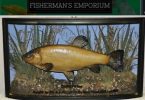The senses that animals possess help them survive in their particular environment, and, in most vertebrates, these comprise sight, hearing, taste, touch and smell. Fish gain an additional advantage from the lines of specialised scales on each of their flanks – their lateral lines – which can provide them with information about objects moving in the water near by, a sort of ‘touch at a distance’.
One means of assessing the relative importance of these senses to different groups of animals is to examine the size of the parts of the brain associated with decoding the messages they convey. In most fish species, the area of the brain of the brain devoted to smell is large and well-developed. From this, we can safely conclude that the ability to detect and react to smells is important to fish – helping them to navigate, find a mate, avoid danger and locate food.
A well-known example of the importance of fish olfaction relates to the amazing spawning migration carried out by Atlantic salmon. The adult fish live at sea until they begin their arduous journey inshore to estuaries and thence upstream to the shallow, fast-flowing headwaters in which they spawn. It has been discovered that this migration is not a random process; individual fish have the ability to return to the very rivers in which they were born several years previously.
The mystery of how salmon can achieve this remarkable feat was solved by a series of classic experiments carried out by a Canadian scientist, Arthur Hassler. His work revealed that the adults are able to detect and navigate towards the individual odour of their home river, which becomes imprinted on the young fish during the short, freshwater stage in their life cycle.
This fact is exploited by scientists when attempting to re-establish salmon runs on formerly polluted rivers. The juvenile salmon are reared in tanks containing minute quantities of a man-made ‘smell’ before they are released in the sea. The designated home river is then selected and labelled with the same smell, with the consequence that, in later life, the adult salmon are hoodwinked into returning to an area which they have falsely memorised as their own birthplace.
There is a gathering body of evidence that other species are capable of such chemical imprinting. Indeed, this ability may help to explain how fish in large bodies of still water, and in the sea, are able to locate their spawning grounds with unfailing accuracy year after year. Once there, their sexual behaviour may be assisted by the release of pheromones, or ‘sex smells’, which help to synchronise the mating process. Certainly, with one type of diminutive sea fish, the blenny, it has been shown that male fish kept in a tank will react to the introduction of water from another tank containing females by changing into their breeding colours.
In detecting the presence of danger, this sense of smell can play an important role in the survival of fish. The German scientist and Nobel prize winner Karl von Frisch discovered the presence of se-called ‘alarm substances’ in the skin of several fish species. He deduced that the release of these odours from a wounded fish may serve to alert the rest of the shoal to the presence of danger to which they might otherwise be unaware.
A simple fish tank experiment will confirm, for instance, that minnows undergo frenzied behaviour when the mucus from one of their predators, pike, is introduced into the tank. However, in this case the response is not innate – minnows which have never been in contact with pike fail to react in this manner.
Smell as a means of finding food undoubtedly occurs in many, if not most, fish species, something which anglers will readily acknowledge. Man’s use of attractive smells to help him catch fish is not new, though. In his 1676 book, ‘The Compleat Angler’, Izaak Walton makes reference to ‘…pastes made with honey or with sugar which, that you may the better beguile this crafty fish, should be thrown into the Pond or place in which you fish…’
Since then, anglers have searched for secret elixirs which will improve their catch rates, and our forefathers swore by all manner of additives, such as tar, aniseed and even saliva to entice fish.
Today, we lace our baits with all manner of natural and artificial smells, and many of the flavours used for commercial purposes can be found in the baits stores of avid carp anglers. Quite what Izaak Walton would have made of concoctions smelling of geranium, bubble gum or maple cream is hard to imagine!
Outlandish though these and many other apparently artificial flavours may appear, there is no denying that they can help anglers catch fish. This indicates that fish are just as capable of responding to attractive odours or flavours as humans, even though they could never have encountered them in real life. Primaeval man can have had no intuitive knowledge of the smell of freshly-ground coffee, chocolate or potato crisps, but neither he nor most of us nowadays would have needed lessons before associating these odours with edible food.
Another avenue for exploration is to mimic the natural smells to which fish respond. In many instances, this recognition can be traced to the presence of certain amino acids, the ‘building blocks’ of proteins – a phenomenon which is common to many fish. As a result of careful experimentation, much of it conducted in Canada and Japan, we now know the key amino acids which will incite feeding behaviour, and this has important commercial implications.
For example, Japanese commercial eel fishermen use short-necked clams to lure eels into their traps, the fish being attracted by the smell emitted by the shellfish. The odour was subjected to detailed chemical analysis, and scientists were able to concoct a near-identical mixture of amino acids which performed the same function admirably and much more conveniently.
This type of smell recognition can help fish avoid other, non-piscine predators. During an expedition to the Arctic Circle, a party of scientists observed how polar bears would capture salmon by waiting alongside the rivers up which they were migrating, As fish passed by, the bears would grab them in their paws, usually with success. However, juvenile bears were less adept at this, and the scientists noticed that salmon would remain downstream of any bear that was inexperienced enough to leave its paw immersed in water.
Why this occurred was discovered following an attack on their camp site by a polar bear, which they were forced to shoot and kill. One of its paws was removed and subjected to study on the scientists’ return home after the expedition. It was found that the sweat glands on the bear’s paw were releasing a cocktail of chemicals – and that one, a particular amino acid, was highly detectable by salmon.
It is tempting to conclude that there may be a perfectly logical explanation why some anglers seem blessed with ‘good luck’ whenever they go fishing. If their hands are clean and sweat less than those of their unsuccessful companions, the baits they handle may be untainted with odours that are unattractive to fish. Conversely, some fish may be able to differentiate between the smells of male and female anglers, finding the latter more attractive. Professor Peter Behan, of Glasgow University, has been quoted as saying: ‘It seems quite possible that they (salmon) could sense the sex hormones of women and be attracted to them.’
Difficult though it may be to take this extraordinary statement seriously, it is noticeable that women are often more successful at the sport than their male counterparts. For male anglers, the moral may be to ensure that you wash your hands before you go fishing and to ask your wife or girl friend to hook on your bait for you!







